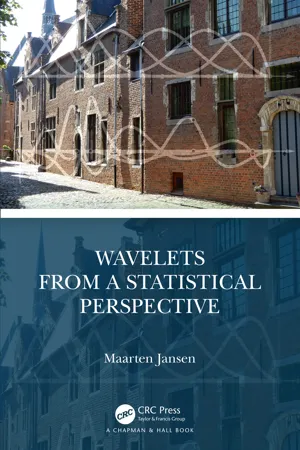
Wavelets from a Statistical Perspective
Maarten Jansen
- 352 páginas
- English
- ePUB (apto para móviles)
- Disponible en iOS y Android
Wavelets from a Statistical Perspective
Maarten Jansen
Información del libro
Wavelets from a Statistical Perspective offers a modern, 2nd generation look on wavelets, far beyond the rigid setting of the equispaced, dyadic wavelets in the early days. With the methods of this book, based on the lifting scheme, researchers can set up a wavelet or another multiresolution analysis adapted to their data, ranging from images to scattered data or other irregularly spaced observations. Whereas classical wavelets stand a bit apart from other nonparametric methods, this book adds a multiscale touch to your spline, kernel or local polynomial smoothing procedure, thereby extending its applicability to nonlinear, nonparametric processing for piecewise smooth data.
One of the chapters of the book constructs B-spline wavelets on nonequispaced knots and multiscale local polynomial transforms. In another chapter, the link between wavelets and Fourier analysis, ubiquitous in the classical approach, is explained, but without being inevitable. In further chapters the discrete wavelet transform is contrasted with the continuous version, the nondecimated (or maximal overlap) transform taking an intermediate position. An important principle in designing a wavelet analysis through the lifting scheme is finding the right balance between bias and variance. Bias and variance also play a crucial role in the nonparametric smoothing in a wavelet framework, in finding well working thresholds or other smoothing parameters. The numerous illustrations can be reproduced with the online available, accompanying software. The software and the exercises can also be used as a starting point in the further exploration of the material.
Preguntas frecuentes
Información
1Wavelets: nonlinear processing in multiscale sparsity sparsity
1.1 Compressing big data
Índice
- Cover Page
- Half-Title Page
- Title Page
- Copyright Page
- Table of Contents
- List of recurrent symbols
- Introduction
- 1 Wavelets: nonlinear processing in multiscale sparsity
- 2 Wavelet building blocks
- 3 Using lifting for the design of a wavelet transform
- 4 Wavelet transforms from factored refinement schemes
- 5 Dyadic wavelets
- 6 Dyadic wavelet design in the frequency domain
- 7 Design of dyadic wavelets
- 8 Approximation in a wavelet basis
- 9 Overcomplete wavelet transforms
- 10 Two-dimensional wavelet transforms
- 11 The multiscale local polynomial transform
- 12 Estimation in a wavelet basis
- Outlook
- References
- Subject index